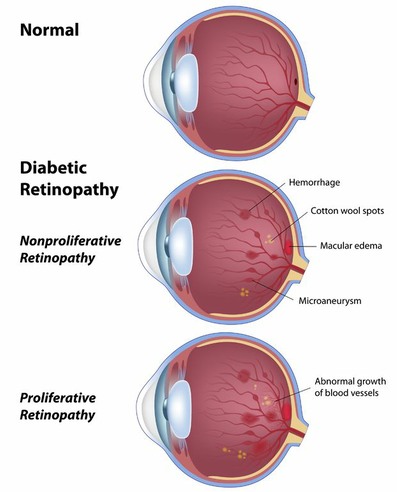






Your family doctor, diabetologist or optometrist can examine for diabetic retinopathy. Photographs are sometimes used to detect abnormalities without any other form of test. If a problem is found you will be referred to a consultant ophthalmologist (a doctor specialising in eyes) at a hospital eye clinic.
Remember, however, that if your vision is getting worse, this does not necessarily mean you have diabetic retinopathy. It may simply be a problem that can be corrected by glasses.
What is the Treatment?
Most sight-threatening diabetic problems can be prevented by laser treatment if it is given early enough. It is important to realise however, that laser treatment aims to save the sight you have - not to make it better. The laser, a beam of high intensity light, can be focused with extreme precision. So the blood vessels that are leaking fluid into the retina can be sealed.
If the new blood vessels are growing, more extensive laser treatment has to be carried out. In eight out of ten cases laser treatment causes the new blood vessels to disappear
Further information about Diabetes:
Diabetes UK (formerly the British Diabetic Association)
The International Diabetics Federation
The American Diabetics Association (ADA)
Information produced by the College of Optometrists
College of Optometrists - Look after your eyes website

Eye health for diabetics
Your eye has a lens and an aperture (opening) at the front, which adjusts to bring objects into focus on the retina at the back of the eye. The retina is made up of delicate tissue that is sensitive to light, rather like the film in the camera.
At the centre of the retina is the macula which is a small area about the size of a pinhead. This is most highly specialised part of the retina and it is vital because it enables you to see fine detail and read small print. The other parts of the retina give you side vision (peripheral vision). Filling the cavity of the eye in front of the retina is a clear jelly-like substance called the vitreous humour.
Diabetes can affect the eye in a number of ways. These usually involve the fine network of blood vessels in the retina - hence the term diabetic retinopathy.
The Importance of Early Treatment
Although your vision may be good, changes can be taking place to your retina that need treatment. And because most sight loss in diabetes is preventable:.
Early diagnosis is vital.
Have an eye examination every year
Do not wait until your vision has deteriorated to have an eye test.













